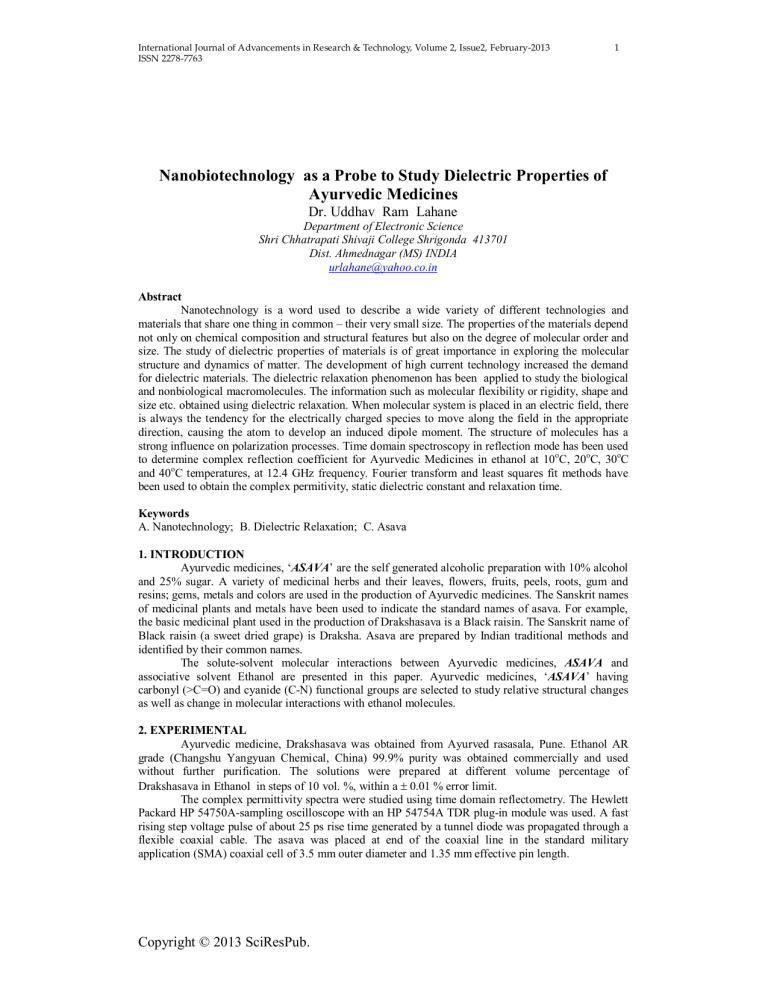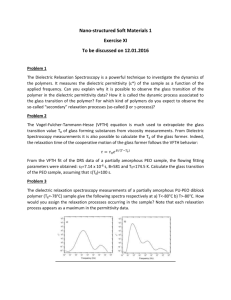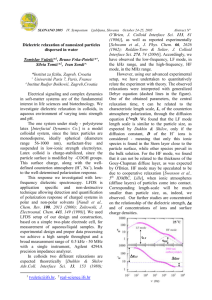Document 14670946

International Journal of Advancements in Research & Technology, Volume 2, Issue2, February-2013 1
ISSN 2278-7763
Nanobiotechnology as a Probe to Study Dielectric Properties of
Ayurvedic Medicines
Dr. Uddhav Ram Lahane
Department of Electronic Science
Shri Chhatrapati Shivaji College Shrigonda 413701
Dist. Ahmednagar (MS) INDIA urlahane@yahoo.co.in
Abstract
Nanotechnology is a word used to describe a wide variety of different technologies and materials that share one thing in common – their very small size. The properties of the materials depend not only on chemical composition and structural features but also on the degree of molecular order and size. The study of dielectric properties of materials is of great importance in exploring the molecular structure and dynamics of matter. The development of high current technology increased the demand for dielectric materials. The dielectric relaxation phenomenon has been applied to study the biological and nonbiological macromolecules. The information such as molecular flexibility or rigidity, shape and size etc. obtained using dielectric relaxation. When molecular system is placed in an electric field, there is always the tendency for the electrically charged species to move along the field in the appropriate direction, causing the atom to develop an induced dipole moment. The structure of molecules has a strong influence on polarization processes. Time domain spectroscopy in reflection mode has been used to determine complex reflection coefficient for Ayurvedic Medicines in ethanol at 10 o
C, 20 o
C, 30 o
C and 40 o
C temperatures, at 12.4 GHz frequency. Fourier transform and least squares fit methods have been used to obtain the complex permitivity, static dielectric constant and relaxation time.
Keywords
A. Nanotechnology; B. Dielectric Relaxation; C. Asava
1. INTRODUCTION
Ayurvedic medicines, ‘ ASAVA ’ are the self generated alcoholic preparation with 10% alcohol and 25% sugar. A variety of medicinal herbs and their leaves, flowers, fruits, peels, roots, gum and resins; gems, metals and colors are used in the production of Ayurvedic medicines. The Sanskrit names of medicinal plants and metals have been used to indicate the standard names of asava. For example, the basic medicinal plant used in the production of Drakshasava is a Black raisin. The Sanskrit name of
Black raisin (a sweet dried grape) is Draksha. Asava are prepared by Indian traditional methods and identified by their common names.
The solute-solvent molecular interactions between Ayurvedic medicines, ASAVA and associative solvent Ethanol are presented in this paper. Ayurvedic medicines, ‘ ASAVA ’ having carbonyl (>C=O) and cyanide (C-N) functional groups are selected to study relative structural changes as well as change in molecular interactions with ethanol molecules.
2. EXPERIMENTAL
Ayurvedic medicine, Drakshasava was obtained from Ayurved rasasala, Pune. Ethanol AR grade (Changshu Yangyuan Chemical, China) 99.9% purity was obtained commercially and used without further purification. The solutions were prepared at different volume percentage of
Drakshasava in Ethanol in steps of 10 vol. %, within a 0.01 % error limit.
The complex permittivity spectra were studied using time domain reflectometry. The Hewlett
Packard HP 54750A-sampling oscilloscope with an HP 54754A TDR plug-in module was used. A fast rising step voltage pulse of about 25 ps rise time generated by a tunnel diode was propagated through a flexible coaxial cable. The asava was placed at end of the coaxial line in the standard military application (SMA) coaxial cell of 3.5 mm outer diameter and 1.35 mm effective pin length.
Copyright © 2013 SciResPub.
International Journal of Advancements in Research & Technology, Volume 2, Issue2, February-2013 2
ISSN 2278-7763
All measurements were done under open load conditions. The change in pulse on reflection from the sample placed in cell was monitored by the sampling oscilloscope. The reflected pulse without sample R
1
(t) and with sample R x
(t) were digitized in 1024 points and stored on disc.
The temperature controller system with a water bath and a thermostat has been used to maintain the constant temperature within the accuracy limit of 1
0
C. The sample cell was surrounded by an insulating container through which, the constant temperature water was circulated.
3. DATA ANALYSIS
The time dependent data were processed to obtain complex reflection coefficient spectra
*
( ) using Fourier transformation (Samulon [12]; Shannon [13]) as
* ( ) j c
d p (
(
)
q )
Where p( ) and q( ) are Fourier transforms of (R
1
(t)-R x
(t)) and (R
1
(t)+R x
(t)), respectively, c is the velocity of light, is the angular frequency, and d is the effective pin length.
The complex permittivity spectra
*
( ) were obtained from reflection coefficient spectra
*
( ) by using the bilinear calibration method (Cole [8,9] et al.). A sample *
( ) spectrum is shown in Fig.1.
The experimental values of
*
( ) are fitted with the Debye equation (Havriliak and Negami [11]; Cole and Cole [8]; Davidson and Cole [10] )
*
0
1
j
with o
,
and as fitting parameters. A nonlinear least- squares fit method (Bevington [7] ) was used to determine the values of dielectric parameters. The values of static dielectric constant (
0
) and dielectric relaxation time ( ) are listed in table 1.
The modified Bruggeman [6] mixture formula, given below, is used to fit experimental data. f
B
om
os
ow ow
os
om
1 / 3
1 [ a ( a 1 ) * V ] * V 1 f ( V ) with “a” as a fitting parameter and ‘f’ can be interpreted as fraction of effective volume V. The relative change in value of “a” reveals amount of interaction between solute and solvent. The values of
Bruggeman factor are listed in table 2.
4. RESULTS AND DISCUSSION
The static permittivity is measure of effective dipole moment per unit volume in mixture.
Relaxation time of biological material can be correlated to the size of molecule, mobility of molecules in liquid, molecular volume, viscosity, and temperature. Decrease in relaxation time can be correlated to decrease in size of molecule as well as to increase in mobility of molecules in liquid. If the polar solute molecules are spherical, and large by comparison with the solvent molecules, then the orientation relaxation of the solute molecules can usefully be described using Debye’s model. In this model the dipolar solute molecules are considered as spheres whose rotation is opposed by the viscosity of the surrounding solvent medium.
When value of numerical fitting parameter “a” is unity, modified Bruggeman mixture formulae reduces to original Bruggeman mixture formulae. Decrease in value of “a” below unity shows increase in effective volume fraction of solvent in mixture.
5. CONCLUSION
The static permittivity increases with addition of ASAVA in ethanol. Decrease in permittivity with increasing temperature is also observed for all concentrations. This raise in permittivity with increasing amount of solute indicates linear increase in effective dipole moment of the system.
Copyright © 2013 SciResPub.
International Journal of Advancements in Research & Technology, Volume 2, Issue2, February-2013 3
ISSN 2278-7763
The variation in relaxation time shows that, the decrease in amount of hydrogen bonding between solute and solvent molecules, which leads to smaller molecular structures rotating fast.
The values of numerical fitting parameter ‘a’ are below unity shows increase in effective volume fraction of solvent in mixture, with decreasing size of ASAVA showing weaker solute solvent interactions.
100 e' e"
80
60
40
20
0
0.01
0.1
1
Freq uency in G Hz (Lo g scale)
10
Fig.1. *( ) spectrum for Drakshasava
Vol. frac.
0.0
0.1
0.2
0.3
0.4
0.5
0
26.85
Table 1
: Temperature dependent dielectric parameters for
10
0
C
Drakshasava-Ethanol mixture
20
0
C 30
0
C 40
0
C
ps
167.04
0
ps
25.91 150.77
0
25.23
ps
128.08
0
24.52
ps
111.29
31.69
37.17
42.26
47.95
53.97
136.16
119.17
100.26
87.87
80.66
30.87
36.05
41.11
46.65
52.59
0.6
0.7
0.8
0.9
1.0
59.91
65.45
71.15
75.84
80.08
71.62
65.55
56.27
47.75
37.34
Copyright © 2013 SciResPub.
58.91
63.33
69.27
73.34
77.44
118.38
98.76
86.12
77.88
70.23
64.62
52.49
45.43
40.91
32.93
30.47
35.36
40.13
45.38
50.47
56.19
60.98
66.86
71.69
76.07
110.44
89.16
76.86
69.97
57.86
51.29
45.34
39.43
36.61
30.75
28.97
33.60
38.47
44.59
48.84
55.58
58.21
65.40
71.07
72.95
93.81
73.06
66.94
63.04
49.68
47.04
44.45
38.72
35.52
27.04
International Journal of Advancements in Research & Technology, Volume 2, Issue2, February-2013 4
ISSN 2278-7763
Table 2
: Ideal, experimental and theoretical values of Bruggeman factor (F
B
)
Volume Ideal for Drakshasava-Ethanol mixture.
10
0
C, a=0.672 20
0
C, a=0.638 30
0
C, a=0.695 40
0
C, a=0.658 fraction of
Drakshasava
Expt. Theor. Expt. Theor. Expt. Theor. Expt. Theor.
0.0 1.00 1.000 1.000 1.000 1.000 1.000 1.000 1.000 1.000
0.7
0.8
0.9
1.0
0.1
0.2
0.3
0.4
0.5
0.6
0.90
0.80
0.70
0.60
0.50
0.40
0.30
0.20
0.10
0.00
0.930
0.852
0.769
0.679
0.582
0.474
0.369
0.252
0.130
0.000
0.937
0.866
0.776
0.684
0.581
0.470
0.358
0.249
0.124
0.000
0.933
0.858
0.776
0.687
0.590
0.487
0.376
0.258
0.133
0.000
0.932
0.873
0.777
0.702
0.598
0.477
0.364
0.254
0.131
0.000
0.927
0.849
0.764
0.673
0.576
0.573
0.364
0.249
0.127
0.000
0.932
0.855
0.757
0.674
0.569
0.471
0.363
0.257
0.140
0.000
0.931
0.855
0.772
0.682
0.586
0.482
0.372
0.255
0.131
0.000
0.970
0.875
0.750
0.702
0.574
0.488
0.357
0.243
0.125
0.000
REFERENCES
[1]. Debye P., Polar Molecules . The Chemical Catalog Co., New York (1929).
[2]. Grant E.H., Dielectric Behavior of Biological Molecules in Solutions.
Clarendon
Press Oxford (1978).
[3]. Froblich H., Theory of Dielectrics.
Oxford University Press London (1949).
[4]. Khirade P.W., Chaudhari A.S., Helambe S.N., Shinde J.B. and Mehrotra S.C.,
J. Chemical and Engineering Data .10 (1999) 1021.
[5]. National Academy of Sciences. Digest of Literature On Dielectrics, Vol. 40;
Washington DC, 1976.
[6]. Bruggeman D.A.G., Ann. Phys . (Leipzing) 5 (1935) 636.
[7]. Bevington P. R., Data reduction and error analysis for the physical sciences ;
McGraw Hill: New York, 1969.
[8]. Cole K.S. & Cole R.H. Dispersion and absorption in dielectrics,
J.Chem. Phys . 1941,9,341-345.
[9]. Cole R.H.; Berbarian J.G.; Mashimo S.; Chryssikos G.; Burns A.; Tombari E.
Time domain reflection methods for dielectric measurements to 10 GHz, J. Appl.
Phys . 1989,66,793-802.
[10]. Davidson D.W.; Cole R.H. Dielectric relaxation in Glycerin,
J. Chem. Phys . 1950,18,1417.
[11]. Havriliak S. & Negami S. A complete plane analysis of -dispersion in some
polymer systems J. Polym. Sci. Polym. Symp . 1966,99-117.
[12]. Samulon H.A. Spectrum analysis of transient response curves,
Proc. IRE 1951,39,175-186.
[13]. Shannon C.E., Communication in the presence of noise, Proc. IRE 1949,37,10.
Copyright © 2013 SciResPub.



